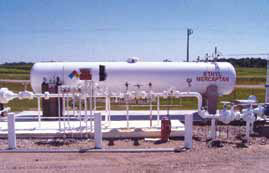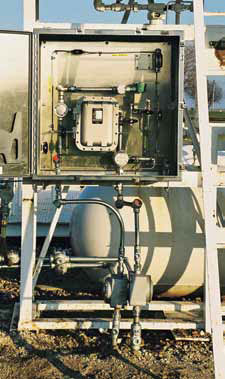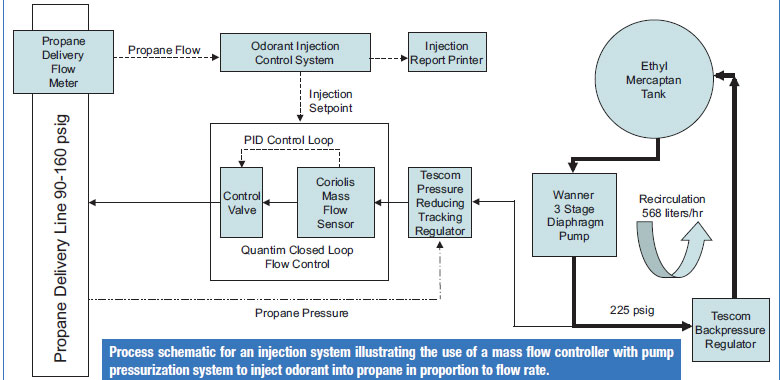The details of a mass-based chemical injection system for an application that requires critical dosing of a trace chemical into a continuous flowing fluid.
In 1937, a natural gas leak at a school in Texas killed 237 students. The gas leak in the school was not detected even though it had been leaking for a long time. To solve the problem of detecting odorless hydrocarbon gaseous fuels, laws were passed that required natural gas and propane to be odorized, so they can be detected by the average human nose at 1/5 the lower explosive limit in air.

Ethyl mercaptan is required to be added to propane to meet DOT requirements for safe transportation and usage.
Propane is primarily sourced as a byproduct of the production of natural gas. To maintain the heating value of natural gas within a narrow range, heavier components (natural gas liquids) are removed from the natural gas near the production well. The liquids are sent to an additional plant where these liquids are separated for higher value uses. Propane is sold as a fuel and is distributed throughout the country via pipeline or rail car.
Mercaptans are sulfur-containing analogs of alcohols (oxygen replaced by sulfur), and the human nose is sensitive to these chemicals. A skunk's smell, for instance, is a mixture of methyl and butyl mercaptans. For propane, the most common mercaptan used for odorization is ethyl mercaptan, which matches the vapor pressure of propane but is also resistant to decomposition. Ethyl mercaptan must be added to propane to meet Department of Transportation standards for over-the-road shipment at a minimum of 1 pound per 10,000 gallons of propane.
Propane Odorization
To efficiently handle the distribution of propane from a single pipeline across a wide geographical area, pipeline storage terminals are built along the pipeline. At periodic intervals, propane is withdrawn from the pipeline and stored in large horizontal cylinders. The delivery window to withdraw from the pipeline is fixed, and it is critical that all delivery equipment be in good operating condition to take the delivery. Any equipment failure can interrupt or stop delivery. Lost propane deliveries equals lost sales . . . resulting in lost profits for the terminal operator.
Propane is odorized as the propane is withdrawn from the pipeline. Odorant injection equipment operating perfectly is critical to the terminal operation's financial health. This is the primary reason why a propane terminal operator in the upper Midwest invested in a more accurate, reliable and consistent propane odorization system.
Positive displacement dosing pumps have been the traditional method for metering odorant into propane. A flowmeter measures the propane delivered to the terminal, and a control system commands the metering pump to periodically inject a known quantity of mercaptan in the propane at a frequency to meet the desired dosing rate. The stroke detector on the pump sends a signal back to the control system as confirmation that odorant is being injected.
If after a number of commands to stroke the pump there is no signal indicating stroking, the terminal control system will stop delivery of propane. Problems with the injection pump might put the delivery of propane into jeopardy.
Metering pump system seals must be replaced on a periodic basis. Pump-based systems are typically set to overdose to compensate for any inaccuracies, with the result being higher operating costs to purchase odorant.
- A better solution was sought that would provide the following benefits:
- Higher accuracy to minimize odorant consumption
- No moving parts for reliable operation, minimal maintenance
- Documentation of actual odorant dosing rates
Mass-Based Odorant Injection
A liquid mass flow controller based on Coriolis technology was selected as a technology that would provide these desired benefits. The operating concept of a mass flow controller-based odorization system is simple. The odorant injection control system takes a reading from the propane delivery meter and calculates the flow set point required to meet the odorant mass/propane volume ratio specification. The flow controller is sized to meet a wide variation in propane delivery rates experienced from summer to winter.

Mass flow injector designed to be mounted in hazardous environment associated with propane terminal operations.
The key technology in the liquid mass flow controller is the Coriolis sensor tube. Coriolis sensor technology has been used in process flow metering since the 1970s, but only recently has the technology been reduced in size to meet the lower flow requirements for injection of chemicals like odorant.
Coriolis mass flow measurement technology is simply a momentum metering device to determine fluid mass flow rate. A vibrating tube acts as the sensor. The momentum of the fluid flowing through the tube will change the shape of the tube as it vibrates. Detectors are used to measure the change in shape and, when calibrated, a linear relationship exists between the degree of tube twist and the fluid's mass flow rate.
Coriolis devices accurately measure fluid mass flow independent of fluid properties such as viscosity and density. Water is used as the calibrating fluid at the factory, and there is no change in accuracy when measuring mercaptans. The measurement accuracy is better than 0.5 percent of rate, and calibration can be NIST traceable. The controller system contains an integrated control valve, which is sized to control the flow of odorant over the range of delivery rates from summer to winter, 0.25 to 25 pounds of odorant/hour.
To drive the fluid through the injector system, the mercaptan must be pressurized to at least 60 psig above line pressure. Nitrogen gas pressurization is not acceptable due to the volume of gas required and the difficulty of disposing the mercaptan saturated gas during odorant tank refilling.

The solution design uses a positive displacement pump in a recirculation loop with a back pressure regulator as a source of pressurized liquid to drive the liquid through the controller and into the propane. A three stage diaphragm pump was selected for this application. Mercaptan is a non-lubricating fluid, and this particular pump design uses an elastomeric seal to isolate the pumping pistons from the mercaptan.
A critical device that maintains a constant differential pressure across the flow controller from summer to winter operation is a dome-loaded differential pressure tracking regulator. The dome of a regulator is connected to the propane pressure, and the regulator will maintain a constant downstream pressure as the propane pressure varies with ambient temperature.
Documenting that the correct amount of mercaptan has been injected in the propane was an important consideration in designing the new system. The previous injector-based system could not provide a positive confirmation of actual odorant delivery. The new system with the flow sensor is capable of providing a printed report of actual odorant injection mass versus propane delivered volume. An integrated printer generates a report detailing the delivery specifics.
Conclusion
The business results for the new system are positive. There have been no propane delivery stoppages due to odorization equipment failures since installation. The injection rate of odorant has been reduced from 1.5 to 1.2 pounds per 10,000 gallons due to the higher accuracy of the system. This has resulted in chemical savings. The system provides a high level of documentation that can be used to prove propane was odorized to meet DOT minimum standards. Finally, the pump pressurization system has saved the purchase cost and handling of nitrogen cylinders.
The basic design of this mass-based chemical injection system could be applied to any application that requires critical dosing of a trace chemical into a continuous flowing fluid.
Pumps & Systems, October 2010

